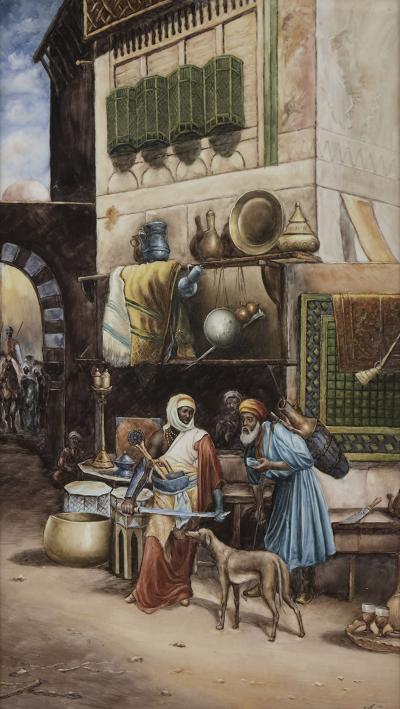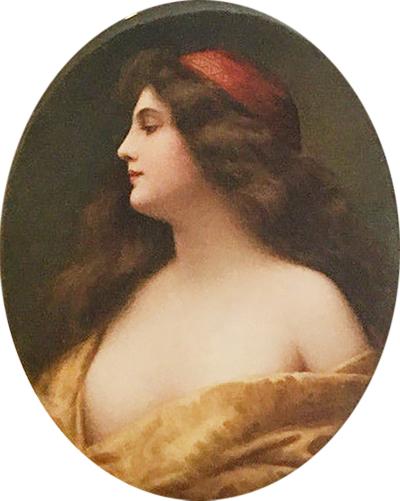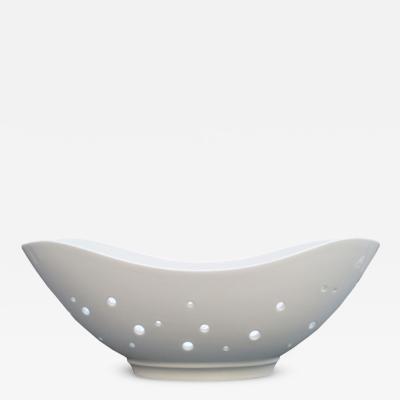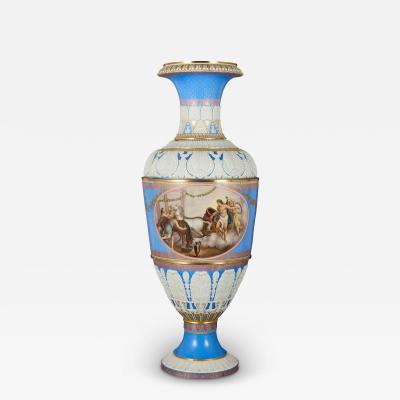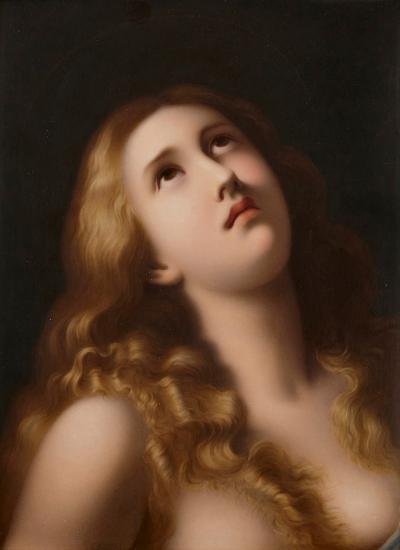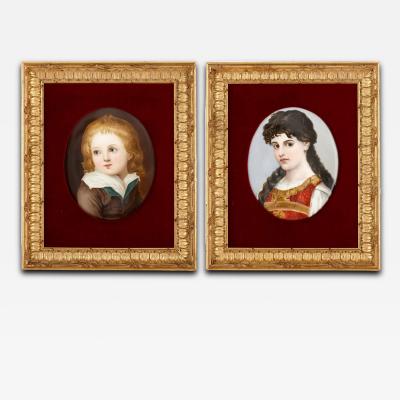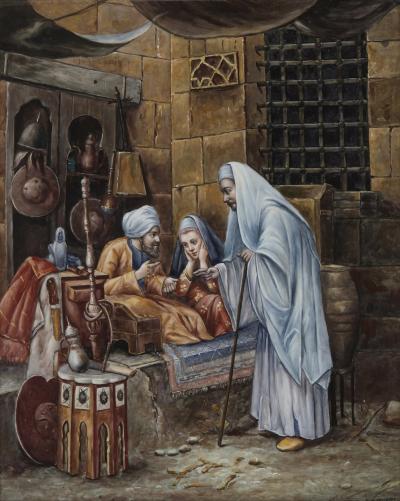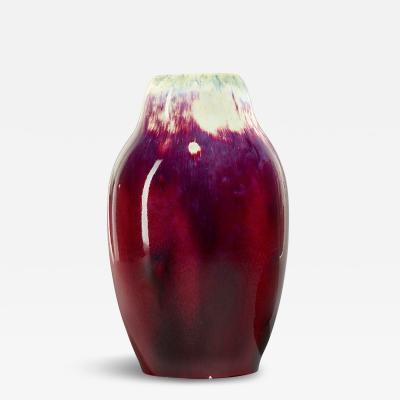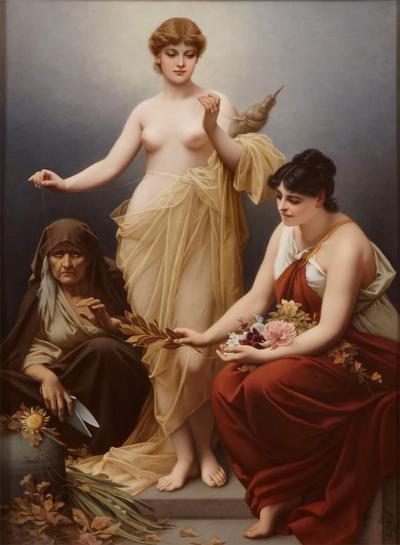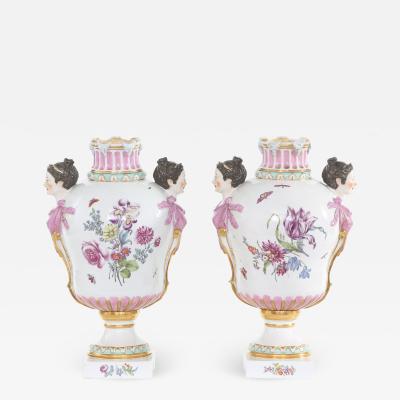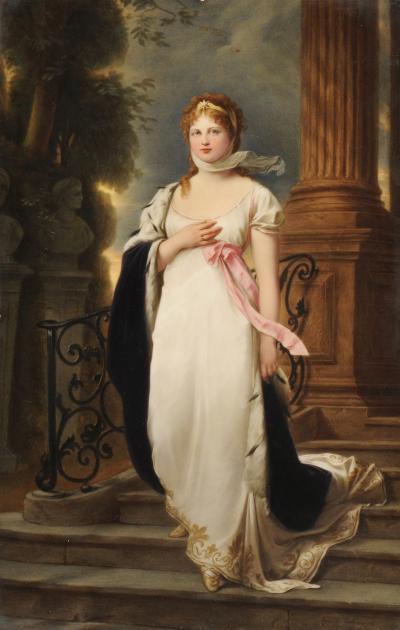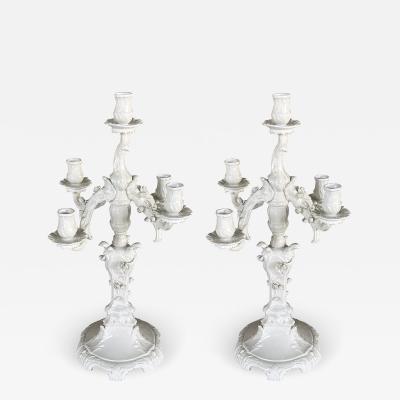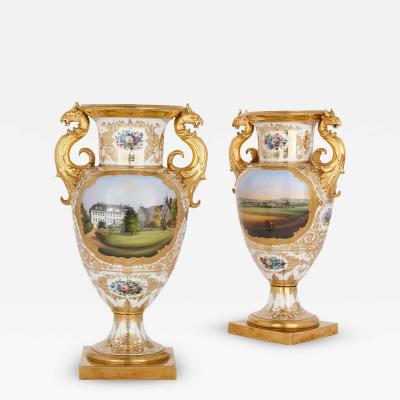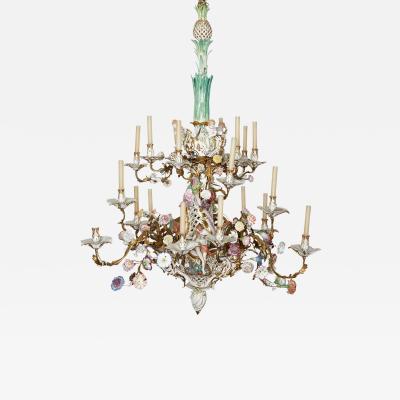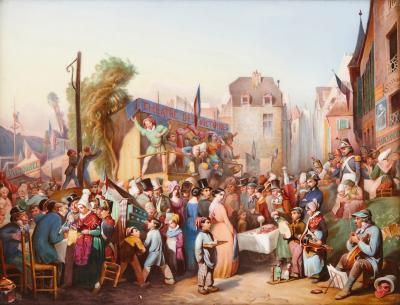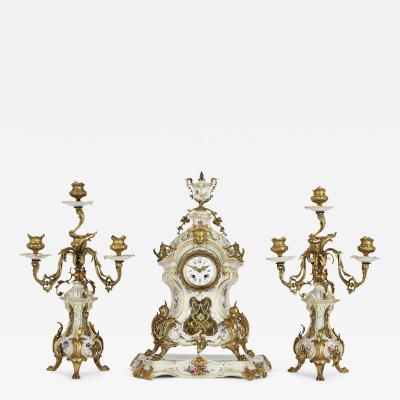Konigliche Porzellan Manufaktur (KPM)
German
The Royal Porcelain Factory in Berlin, known as KPM (Königliche Porzellan-Manufaktur), was established in 1763 by King Frederick II of Prussia, popularly referred to as Frederick the Great. Its origins trace back to earlier private ventures attempting to produce porcelain, dubbed "white gold," in the mid-18th century under royal patronage.
KPM's trademark cobalt blue sceptre emblem, a nod to Brandenburg's electoral coat-of-arms, is stamped on each piece. From its inception, KPM has been recognized for its exquisite dishware and intricate porcelain figurines, many of which maintain their original designs after over 200 years of production. Frederick the Great, humorously calling himself his "best customer," had a fondness for the Rococo style, a testament to which can be seen in the designs of his palaces.
Among KPM's notable creations are the iconic Urbino, Urania, and Arkadia tableware sets, the latter designed by Trude Petri to commemorate KPM's 175th anniversary. The Arkadia medallions were crafted by Siegmund Schütz, while the Urania set was produced post-war, following similar designs.
KPM's history began with attempts to establish a porcelain manufactory in Berlin, first initiated in 1751. Despite early challenges, including the Seven Years' War, the venture ultimately led to KPM’s founding. Frederick II officially acquired the struggling manufactory in 1763, transforming it into a royal enterprise, where he introduced progressive labor practices, ensuring fair wages and working conditions for its employees.
During the Rococo period, KPM flourished, catering primarily to Frederick the Great. He commissioned elaborate dinner services, some featuring intricate designs that echoed the grandeur of his royal residences. The manufactory produced a range of exquisite porcelain, characterized by its delicate coloring and high-quality overglaze enamel work.
As the years progressed, KPM transitioned into Neoclassical styles, creating works that retained the craftsmanship of its Rococo roots while adopting more austere forms. Under Frederick William II, KPM continued to prosper, producing celebrated designs such as the KURLAND service, which remains a hallmark of the brand.
Throughout the 19th century, KPM was a pioneer in pictorial porcelain, capturing the evolving cityscapes of Berlin and Potsdam through its detailed works. Technological advancements in the late 19th century, particularly innovations in underglaze colors, propelled KPM into the forefront of the ceramic industry, laying the groundwork for modern artistic movements like Art Nouveau.
The 20th century brought both challenges and achievements for KPM. Influenced by Bauhaus principles, the factory sought to create functional yet artistic household porcelain. However, the rise of the National Socialists in the 1930s impacted many artists associated with KPM, leading to significant losses in talent and creativity.
Following World War II, KPM faced reconstruction, relocating temporarily before returning to its historic Berlin location in 1957. In the years that followed, KPM embraced its heritage while modernizing its production techniques. The factory has since celebrated anniversaries with significant exhibitions, showcasing its vast collection and craftsmanship.
Today, KPM continues to produce an extensive array of porcelain, from tableware to vases and figurines, with designs that span centuries and styles. Each piece embodies the meticulous artistry and dedication to quality that have defined the Royal Porcelain Factory for over 250 years, making it a cherished institution in the world of fine ceramics.
KPM's trademark cobalt blue sceptre emblem, a nod to Brandenburg's electoral coat-of-arms, is stamped on each piece. From its inception, KPM has been recognized for its exquisite dishware and intricate porcelain figurines, many of which maintain their original designs after over 200 years of production. Frederick the Great, humorously calling himself his "best customer," had a fondness for the Rococo style, a testament to which can be seen in the designs of his palaces.
Among KPM's notable creations are the iconic Urbino, Urania, and Arkadia tableware sets, the latter designed by Trude Petri to commemorate KPM's 175th anniversary. The Arkadia medallions were crafted by Siegmund Schütz, while the Urania set was produced post-war, following similar designs.
KPM's history began with attempts to establish a porcelain manufactory in Berlin, first initiated in 1751. Despite early challenges, including the Seven Years' War, the venture ultimately led to KPM’s founding. Frederick II officially acquired the struggling manufactory in 1763, transforming it into a royal enterprise, where he introduced progressive labor practices, ensuring fair wages and working conditions for its employees.
During the Rococo period, KPM flourished, catering primarily to Frederick the Great. He commissioned elaborate dinner services, some featuring intricate designs that echoed the grandeur of his royal residences. The manufactory produced a range of exquisite porcelain, characterized by its delicate coloring and high-quality overglaze enamel work.
As the years progressed, KPM transitioned into Neoclassical styles, creating works that retained the craftsmanship of its Rococo roots while adopting more austere forms. Under Frederick William II, KPM continued to prosper, producing celebrated designs such as the KURLAND service, which remains a hallmark of the brand.
Throughout the 19th century, KPM was a pioneer in pictorial porcelain, capturing the evolving cityscapes of Berlin and Potsdam through its detailed works. Technological advancements in the late 19th century, particularly innovations in underglaze colors, propelled KPM into the forefront of the ceramic industry, laying the groundwork for modern artistic movements like Art Nouveau.
The 20th century brought both challenges and achievements for KPM. Influenced by Bauhaus principles, the factory sought to create functional yet artistic household porcelain. However, the rise of the National Socialists in the 1930s impacted many artists associated with KPM, leading to significant losses in talent and creativity.
Following World War II, KPM faced reconstruction, relocating temporarily before returning to its historic Berlin location in 1957. In the years that followed, KPM embraced its heritage while modernizing its production techniques. The factory has since celebrated anniversaries with significant exhibitions, showcasing its vast collection and craftsmanship.
Today, KPM continues to produce an extensive array of porcelain, from tableware to vases and figurines, with designs that span centuries and styles. Each piece embodies the meticulous artistry and dedication to quality that have defined the Royal Porcelain Factory for over 250 years, making it a cherished institution in the world of fine ceramics.
Konigliche Porzellan Manufaktur (KPM)
KPM style porcelain plaque of Orientalist bazaar scene
H 30.71 in W 20.87 in D 1.97 in
$ 18,750
Konigliche Porzellan Manufaktur (KPM)
KPM Porcelain Flower Boat Germany
H 6 in W 17 in D 7 in
$ 3,400
Access Trade Price
Konigliche Porzellan Manufaktur (KPM)
Very large antique German hand-painted porcelain vase by KPM
H 66.93 in DIA 25.59 in
$ 225,000
Konigliche Porzellan Manufaktur (KPM)
19th Century KPM porcelain plaque, after Old Master painting
H 20.87 in W 19.69 in D 3.15 in
$ 9,375
Konigliche Porzellan Manufaktur (KPM)
Porcelain plaque painted with Mary Magdalene by KPM
H 12.6 in W 10.24 in D 1.18 in
$ 5,750
Konigliche Porzellan Manufaktur (KPM)
Two antique KPM painted porcelain plaques in giltwood frames
H 18.5 in W 15.35 in D 1.57 in
$ 12,000
Konigliche Porzellan Manufaktur (KPM)
Berlin KPM Porcelain Plaque "Mary Magdalene"
H 8 in W 6 in
$ 3,500
Konigliche Porzellan Manufaktur (KPM)
Orientalist KPM porcelain plaque of interior scene
H 27.95 in W 25.2 in D 1.57 in
$ 15,000
Konigliche Porzellan Manufaktur (KPM)
Glazed Oxblood Vase by Hermann Seger for KPM
H 12 in DIA 7 in
$ 1,850
Konigliche Porzellan Manufaktur (KPM)
Very fine and large KPM porcelain plaque of The Three Fates
H 20.87 in W 16.93 in D 3.54 in
$ 70,000
Konigliche Porzellan Manufaktur (KPM)
porcelain plaque of the Queen of Prussia, Duchess Louise of Mechlenburg-Strelitz
H 18.11 in W 12.6 in D 0.79 in
$ 30,000
Konigliche Porzellan Manufaktur (KPM)
Pair of KPM porcelain plaques after Spanish Baroque paintings by Murillo
H 16.93 in W 14.57 in D 1.57 in
$ 22,500
Konigliche Porzellan Manufaktur (KPM)
KPM Berlin Blanc de Chine Five-light Rococo Style Candelabra
H 24 in DIA 14 in
$ 5,800
Konigliche Porzellan Manufaktur (KPM)
Pair KPM Porcelain Vases "Ribbon" Germany circa 1960
H 10 in W 9 in D 7 in
$ 8,800
Access Trade Price
Konigliche Porzellan Manufaktur (KPM)
'Oriental girl' German KPM porcelain plaque
H 25.59 in W 18.11 in
$ 15,000
Konigliche Porzellan Manufaktur (KPM)
Large pair of German porcelain vases by KPM
H 16.54 in W 9.84 in D 7.48 in
$ 56,250
Konigliche Porzellan Manufaktur (KPM)
KPM porcelain and gilt bronze chandelier
H 66.93 in DIA 44.09 in
$ 235,000
Access Trade Price
Konigliche Porzellan Manufaktur (KPM)
Porcelain plaque of a 19th Century German market by KPM
H 13.39 in W 15.35 in D 2.36 in
$ 15,000
Konigliche Porzellan Manufaktur (KPM)
Large Renaissance Style Painted Porcelain Plaque
H 19.69 in W 25.2 in D 2.36 in
$ 15,000
Konigliche Porzellan Manufaktur (KPM)
KPM porcelain and gilt bronze Rococo style clock set
H 20.08 in W 14.17 in D 6.69 in
$ 30,000
